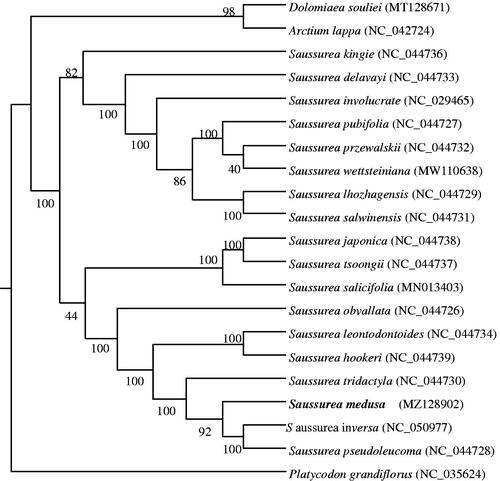Abstract
Saussurea medusa is an important traditional Tibetan medicinal plant in China. In this study, we assembled the complete chloroplast (cp) genome of S. medusa. The complete S. medusa chloroplast genome is a circular molecular structure of 152,257 bp in length with coding GC 37.93%, consisting of two inverted repeats (25,204 bp) separated by a large single-copy region (83,334 bp) and a small single-copy region (18,515 bp). The complete chloroplast genome of S. medusa contained 130 genes, including 87 protein-coding genes, 35 tRNA genes, and eight rRNA genes. Phylogenetic analysis shows that S. medusa is most closely related to Saussurea inversa and Saussurea pseudoleucoma. The complete chloroplast genome sequence of S. medusa facilitates the phylogenetic studies of Asteraceae.
Saussurea medusa Maxim. (Maximowicz Citation1881) belongs to the Saussurea Candolle, Asteraceae family. There are 289 species (191 endemics) of Saussurea in China (Wu et al. Citation2011). The plant has been commonly used as a traditional Tibetan medicine for the treatment of inducing abortion, nourishing blood, detoxifying (Wei et al. Citation2020). At present, the research of S. medusa mainly focuses on chemical composition, pharmacological action, and cell culture. However, there are few studies on chloroplast genes. So we assembled and characterized the complete chloroplast genome sequence of S. medusa to provide information for the identification of Saussurea Candolle, as well as assist the further phylogenetic study of Asteraceae.
The total genomic DNA of S. medusa was extracted from the fresh leaves that were collected in Jiangda County of Xizang (Tibet) Autonomous Region, China (N32°9′, E97°57′). The voucher samples (542122190722379LY) were deposited at the Herbarium of the Chongqing Academy of Chinese Materia Medica (SM, http://www.cqacmm.com/, Xiang Liu, [email protected]), Chongqing, China. Genomic DNA was extracted by using the modified CTAB method (Doyle and Doyle Citation1987). Total DNA was used for the shotgun library construction. After cluster generation, libraries were sequenced on an Illumina Novaseq 6000 platform and 150 bp paired-end reads were generated. About 3.0 G base pairs of sequencing data in total were obtained and then de novo assembled using the program GetOrganelle v1.5 (Jin et al. Citation2018). The chloroplast genome annotation was performed through the online program GeSeq (Tillich et al. Citation2017) and CPGAVAS2 (Shi et al. Citation2019), followed by manual correction. The annotated genomic sequence has been registered into GenBank with the accession number (MZ128902).
The complete S. medusa chloroplast genome is a circular molecular structure of 152,257 bp in length with coding GC 37.93%, consisting of two inverted repeats (25,204 bp) separated by a large single-copy region (83,334 bp) and a small single-copy region (18,515 bp). The complete chloroplast genome of S. medusa contained 130 genes, including 87 protein-coding genes, 35 tRNA genes, and eight rRNA genes.
To investigate the phylogenetic relationship of S. medusa, the phylogenetic tree was generated by the maximum likelihood (ML) method from alignments created using the MAFFT v7 (Katoh et al. Citation2017), and RAxML (v8.2.10) (Stamatakis Citation2014). We selected twenty published complete chloroplast genomes from GenBank to assess the genetic and phylogenetic relationship with S. medusa (19 Asteraceae and one Campanulaceae). As shown in the phylogenetic tree (), S. medusa is most closely related to S. inversa and S. pseudoleucoma. The result was consistent with the traditional plant morphological taxonomy. The complete chloroplast genome sequence of S. medusa facilitates the phylogenetic studies of Asteraceae.
Disclosure statement
No potential conflict of interest was reported by the authors.
Data availability statement
The genome sequence data that support the findings of this study are openly available in GenBank of NCBI (https://www.ncbi.nlm.nih.gov/) under the accession MZ128902. The associated BioProject, SRA, and Bio-Sample numbers are PRJNA728186, SRR14470736, and SAMN19071285, respectively.
Additional information
Funding
References
- Doyle JJ, Doyle JL. 1987. A rapid DNA isolation procedure for small quantities of fresh leaf tissue. Phytochem Bull. 19:11–15.
- Jin JJ, Yu WB, Yang JB, et al. 2018. GetOrganelle: a simple and fast pipeline for de novo assembly of a complete circular chloroplast genome using genome skimming data. bioRxiv. 256479.
- Katoh K, Rozewicki J, Yamada KD. 2017. MAFFT online service: multiple sequence alignment, interactive sequence choice and visualization. Briefings Bioinf. 4:1–7.
- Maximowicz CJ. 1881. Diagnoses plantarum novarum asiaticarum. IV Bull L’Acad Imper Sci St Pét. 27:425–560.
- Shi L, Chen H, Jiang M, Wang L, Wu X, Huang L, Liu C. 2019. CPGAVAS2, an integrated plastome sequence annotator and analyser. Nucleic Acids Res. 47:65–73.
- Stamatakis A. 2014. RAxML version 8: a tool for phylogenetic analysis and post-analysis of large phylogenies. Bioinformatics. 30(9):1312–1313.
- Tillich M, Lehwark P, Pellizzer T, Ulbricht-Jones ES, Fischer A, Bock R, Greiner S. 2017. GeSeq–versatile and accurate annotation of organelle genomes. Nucleic Acids Res. 45(W1):W6–W11.
- Wei YS, Zhaxi DW, Li Y. 2020. Chinese and Tibetan medicine resources in Rioche. Beijing: China Textile Press; p. 356.
- Wu ZY, Raven PH, Hong DY, editors. 2011. Flora of China (Asteraceae), Vol. 20–21. Beijing; St. Louis (MO): Science Press; Botanical Garden Press; p. 56.

